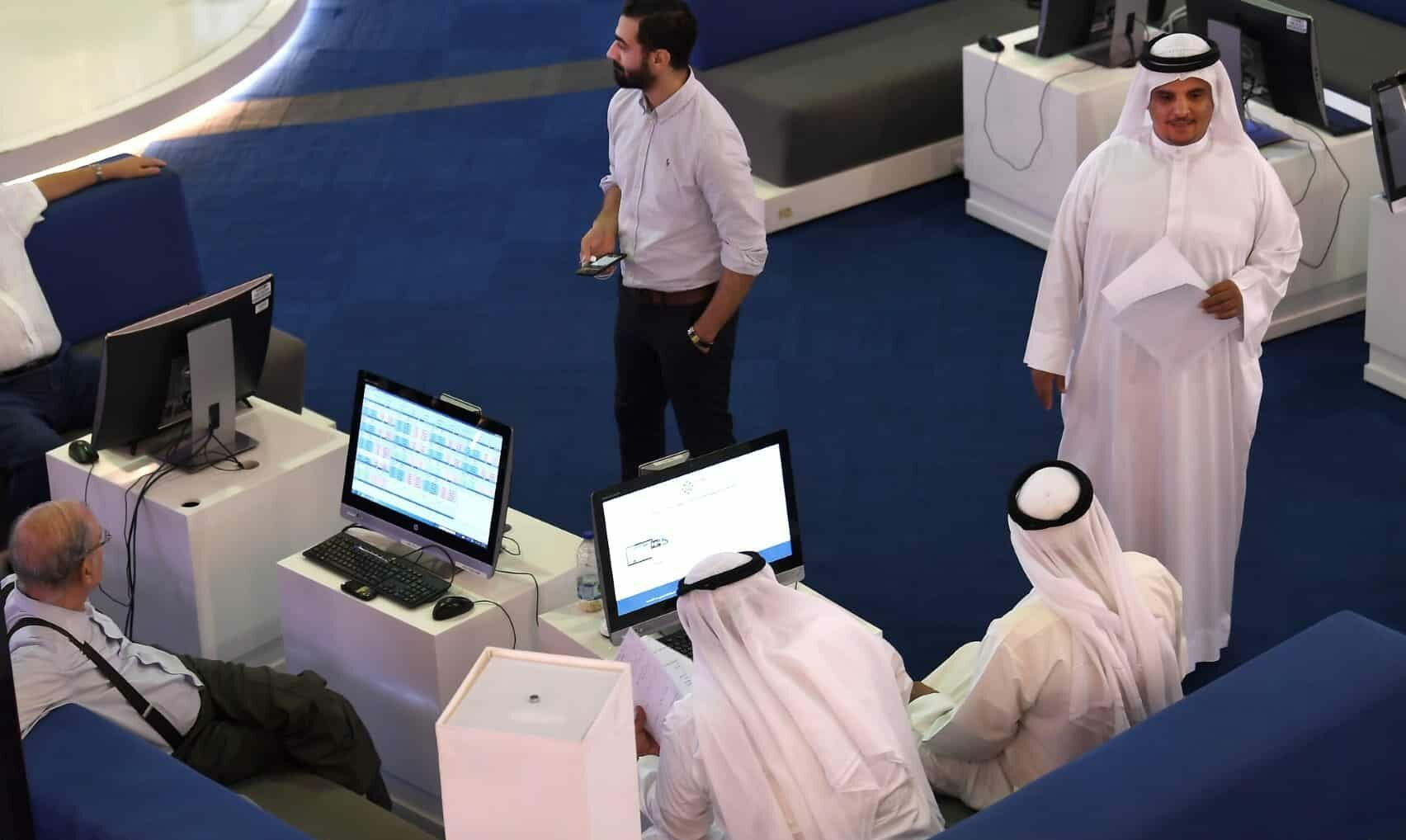DUBAI, UAE — The commodity sector remains on the backfoot this month after a supportive focus on China’s reopening was replaced by fresh growth and demand concerns, not least in the US where recent economic reports have shown continued strength in the labor market while inflationary pressures have eased by less than expected. Continued strength in these numbers has forced the Fed to turn up the hawkish rhetoric, and the market has responded by raising the expected terminal Fed funds rate while at the same time sending bond yields and the dollar higher, thereby hurting risk sentiment across stock and commodity markets.
Meanwhile, geopolitical risks remain elevated, which may further speed up the transition to regionalization following two decades of unconstrained globalization. Reshoring and friend sharing may push up prices, thereby supporting our view that inflation is unlikely to drop to the levels that are being targeted by central banks, and currently priced in by the market. In addition to a commodity-intensive green transformation, and continued growth in China and India, we see limited downside to the sector beyond the current weakness which is driven more by a lack of market confidence than an actual slowdown in demand.
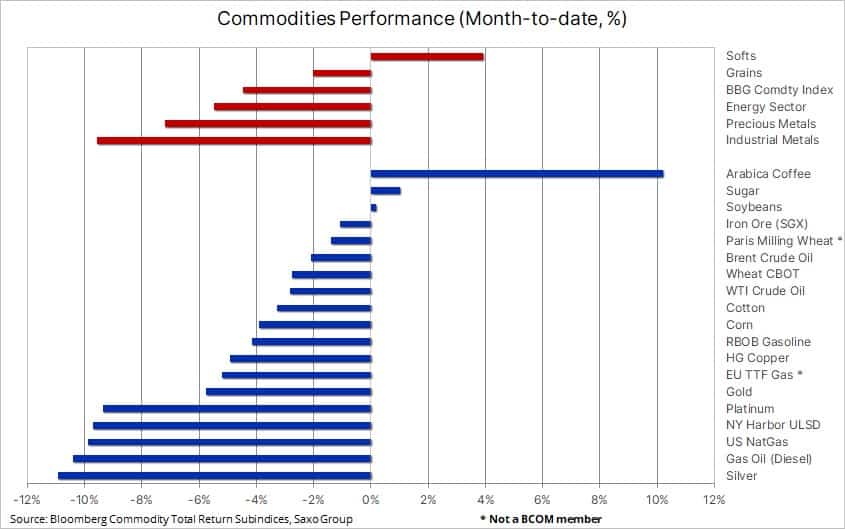
One year on from Russia’s attack on Ukraine
This week also marks the tragic one-year anniversary of Putin’s so-called special operation, which was only expected to last for a few days. The attack on February 24 last year was a major miscalculation on Putin’s part, with Russia having suffered one military and economic defeat after another. Part of the miscalculation was Putin’s belief that the rest of the world would roll over just as they did following the annexation of Crimea in 2014. However, attacking a sovereign nation with an elected government on Europe’s doorstep was not going to be tolerated and, in the weeks and months that followed, Russia was increasingly targeted by sanctions.
Russia and Ukraine are both major suppliers of raw materials to the global economy and, faced with the risk of supply being disrupted, the weeks that followed the invasion saw several key commodities—from crude oil and natural gas to wheat and some industrial metals—rally sharply. Ukraine, a major supplier of grains to the global market, saw its supply lines being attacked and disrupted, thereby temporarily sending wheat futures in Chicago to a record last March before reversing lower after a UN-sponsored grain export corridor was opened.
Russia was hit by very severe sanctions resulting in a voluntary buyers’ strike which, for a brief period, saw Brent crude oil spike to near $140 a barrel while the gasoil (diesel) futures in Europe at one point hit $223 a barrel. The London Metal Exchange index meanwhile surged to a record high, led by nickel and aluminum—the latter a very energy intensive metal to produce—while nitrogen fertilizer produced from natural gas also went on a tear.
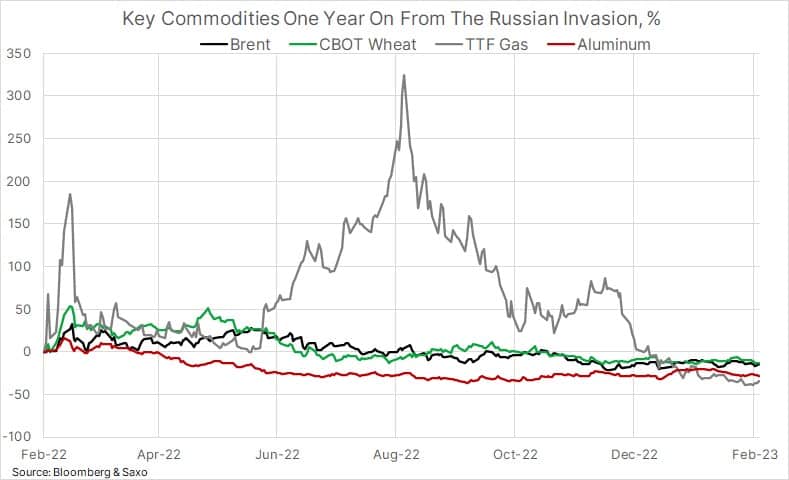
A roller coaster year for global natural gas prices
An attempt to reduce the resolve of Europeans through higher gas prices remains Putin’s biggest economic miscalculation. Gas and power prices did initially surge higher last summer when Gazprom successively turned off the taps on three of its five major gas pipelines to Europe, thereby reducing its pipeline exports by around 75 percent. While a period of market panic followed, the timing of the reduction in flows during the low summer demand season provided Europe with more time to source gas from other suppliers while also putting in place initiatives that would help reduce demand during the winter period.
One year on and the Dutch TTF benchmark gas contract is trading more than 40 percent below pre-invasion levels. This has been driven by a combination of mild winter weather and, in most cases, a voluntary reduction in demand from consumers and industry.
Earlier this week, Eurostat wrote on its website that EU consumption of natural gas had dropped 19.3 percent between August and January, compared with the five-year average consumption for this period. Adding up total gas flows from rising LNG imports, stable supply from Norway and the trickle from Russia, we find a year-on-year drop of 20 percent. These developments have preserved gas in storage to the extent that EU gas storage sites are currently 63 percent full compared with a pre-invasion level of 31 percent. Apart from a strong pick up in gas demand from China, these developments should see Europe comfortably through next winter as well.
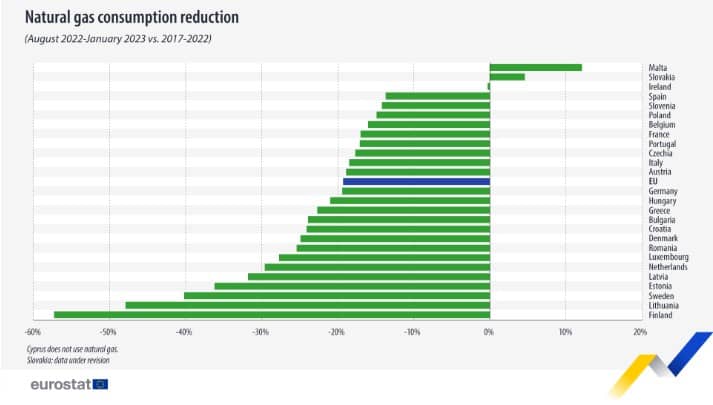
Crude oil remains rangebound and near support
Crude oil, rangebound since November, continues to lack the directional input that may see it break out of established ranges, for Brent between $80 and $89, and for WTI between $73 and $83. The recent weakness has, as mentioned, primarily been driven by a lower investment appetite with a supportive pickup in demand from China and India being more than offset by macroeconomic developments, not least the prospect of US interest rates moving higher and staying there for longer.
Following its longest losing streak this year, crude oil saw fresh buying as prices approached the lower end of the current range. Bids emerged despite a ninth straight week of rising US crude inventories—taking total stocks to 479 million barrels and their highest since May 2021. Refinery demand for crude oil towards production of fuel products such as diesel and gasoline has taken a hit, along with demand for gas, both in Europe and not least in the US, following warmer than expected weather across the Northern Hemisphere this winter.
Despite strong exports, especially to Europe, rising US crude stocks are likely to weigh on the market and investor sentiment, especially WTI which has seen the front end of the forward curve trade in contango for a while now. The opposite remains the case for Brent, the global benchmark, where a backwardation has been supported by sanctions against Russian oil, OPEC+ production restraint and the mentioned demand recovery in China. The impact on investment returns between these two different curve structures are clearly visible in the chart below which shows the one-year total return in Brent and WTI. Taking the roll into account, an ETF tracking Brent crude has returned 10.4 percent during the past year while a similar investment in WTI would have led to a 5 percent loss.
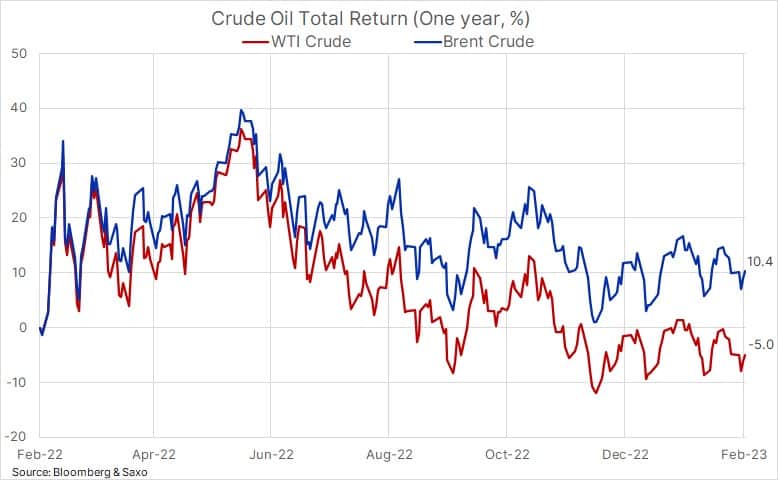
US dollar dictates gold’s short-term direction
Gold slumped below $1820 this week and, following a more than $340 rally since early November, the market has now given back close to $140. The trigger which saw the price trade lower after being rejected at $1950 was a recent batch of stronger than expected US economic data—highlighting the challenge the US Federal Reserve is facing as it attempts to force inflation lower towards its long-term target of 2 percent. This has led to renewed strength following several months of dollar weakness, while bond yields have moved higher. Both developments, given their inverse correlation, have provided gold with fresh headwinds.
For now, gold is likely to take much of its directional inspiration from the dollar and, until we see another rollover, gold will continue to look for support. Demand for gold remains uneven, but in the short term we anticipate that central bank demand will more than offset a continued lack of appetite from investors in the ETF market where total holdings continue to be reduced, down by almost 50 tons since early November when gold began its strong run up in prices.
Until macro-economic developments turn more friendly, and the dollar rolls over yet again, the risk remains of a further weakness towards $1788 followed by the 200DMA at $1,776. US PCE deflator, the Fed’s preferred inflation gauge, was closely watched on Friday with the stronger than expected result clearly indicating that inflation is heading in the wrong direction, and that further action is needed from the FOMC, potentially putting a 50 basis point hike back in play. The core PCE inflation rose 0.6 percent on the month with the year-on-year rise accelerating to 4.7 percent.
Backwardation points to continued strength in commodities
The tightness seen across the commodity sector which helped drive strong performance during the last few years has eased in recent months while China struggled with lockdowns, but despite concerns of an economic downturn, the bulk of the major commodities tracked in the Bloomberg Commodity Index – those with an index weight above 2.5 percent – continue to trade in backwardation.
The one-year average weighted implied roll yield, however, is currently trading at a small contango as the whole index is being pulled down by a massive 55 percent one-year contango in natural gas. Given our expectations for a strong rebound in China and a shallow economic slowdown elsewhere, we expect an investor-friendly backwardation will start to rise from the second quarter and onwards, primarily driven by the energy sector.
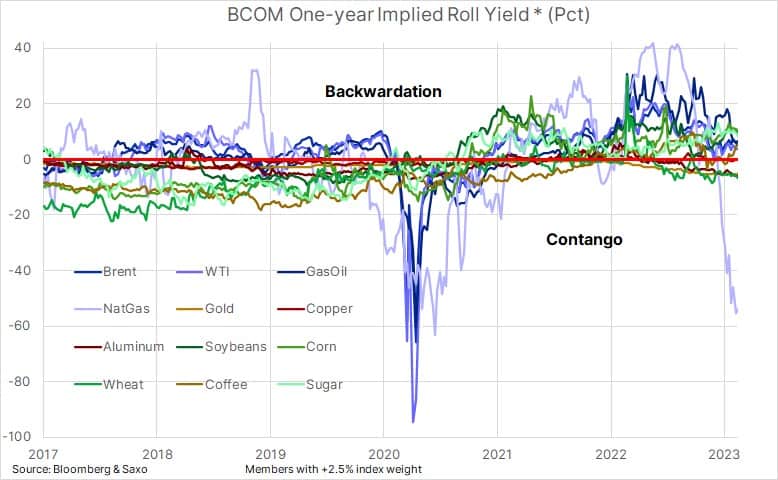
Ole S Hansen is the Head of Commodity Strategy at Saxo Bank.
The opinions expressed are those of the author and may not reflect the editorial policy or an official position held by TRENDS.


